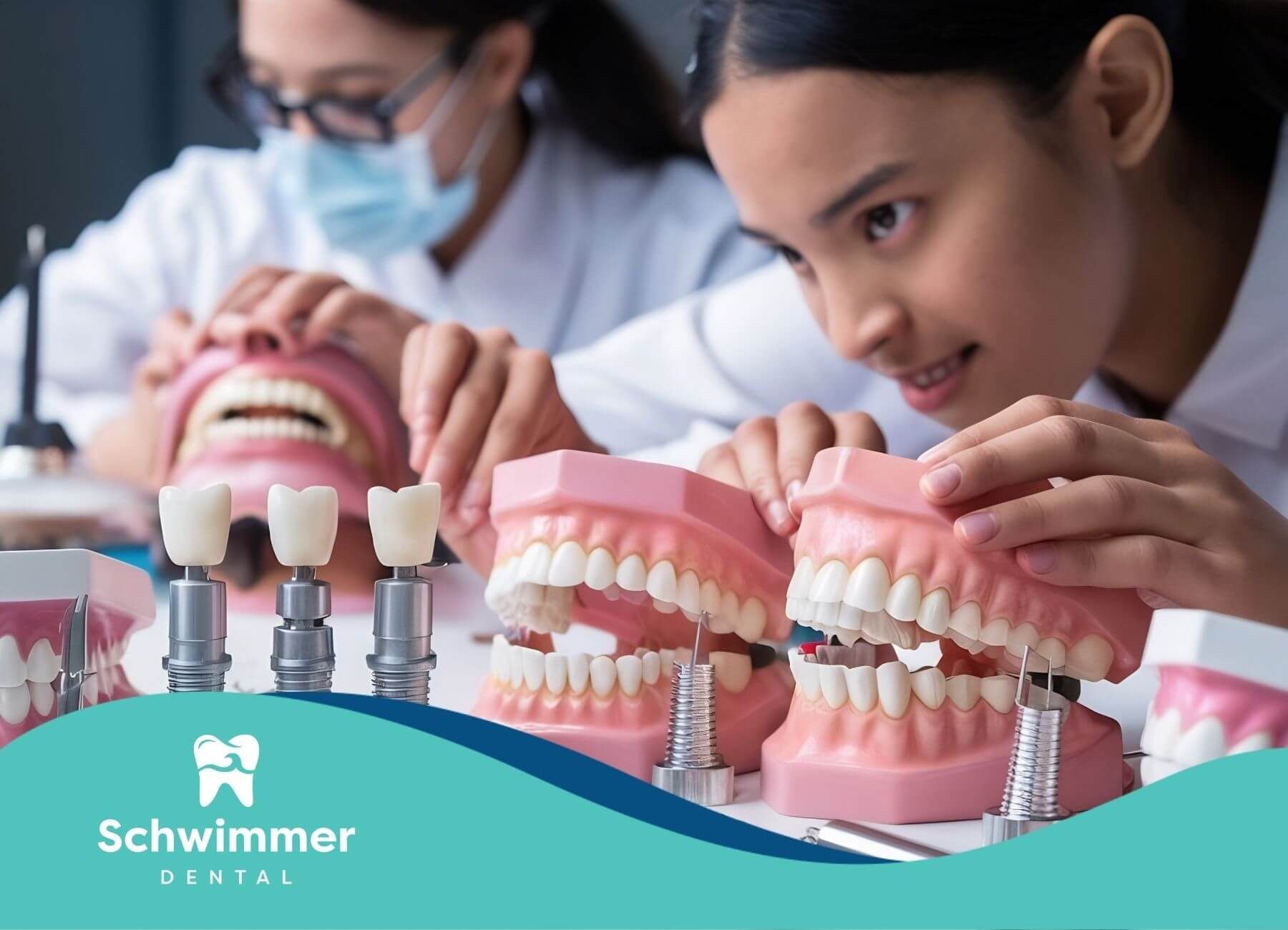Key Differences in Dental Bridge vs Implant Durability
Dental restorations have evolved significantly, yet the debate over dental bridge vs implant durability remains central for patients and practitioners. Durability differences can influence not only long-term oral health but also cost-effectiveness and maintenance needs. This article examines durability metrics for both solutions, including typical lifespan ranges, material influences, care requirements, and clinical survival rates.
Understanding Dental Bridges
Dental bridges replace one or more missing teeth by anchoring an artificial pontic to adjacent abutment teeth or implants. They come in several designs and material combinations that affect both function and lifespan.
Bridge Types And Materials
- Fixed‐Fixed Bridge: A pontic supported by crowns on two natural abutment teeth.
- Cantilever Bridge:
A pontic anchored to a single adjacent tooth, suitable when space or tooth alignment is limited.
- Maryland Bridge: A resin‐bonded design that uses metal or porcelain wings bonded to the backs of adjacent teeth, offering a minimally invasive option.
Common materials include porcelain-fused-to-metal (PFM), all-ceramic, and metal alloys. Metal-ceramic bridges combine strength and aesthetics but may reveal a dark metal margin over time. All-ceramic options—such as zirconia or lithium disilicate—deliver superior appearance, though certain ceramics may chip under heavy loads.
Average Bridge Lifespan
On average, dental bridges last between five and 15 years, influenced by material quality, oral hygiene, and bite forces. Proper care and regular professional cleanings can extend this range, with studies reporting 10-year survival rates from 79% to 94% for fixed dental prostheses.
Exploring Dental Implants
Dental implants replace missing teeth by inserting a titanium or zirconia post into the jawbone, then attaching a custom crown. This semipermanent solution mimics natural tooth roots and supports bone health.
Implant Types Overview
- Endosteal Implants:
The most common type, placed directly into the jawbone.
- Subperiosteal Implants:
Positioned under gum tissue but above the bone, used when bone height is insufficient.
- Zirconia Implants:
An emerging metal-free option offering high biocompatibility and natural color.
- Implant-Supported Bridges: Multiple implants support a series of crowns or a fixed denture, ideal for replacing several adjacent teeth.
Average Implant Lifespan
Dental implants often outperform other restorations in longevity. With proper care and healthy bone support, the implant post can last decades or a lifetime, while the attached crown typically needs replacement after 10 to 15 years due to wear. Titanium’s biocompatibility promotes osseointegration—fusion to the jawbone—that preserves bone density and stability.
Comparing Lifespan Characteristics
Lifespan data illustrate why durability often drives the bridge versus implant decision. The table below summarizes typical ranges and related features.
| Feature | Dental Bridge | Dental Implant |
|---|---|---|
| Average Lifespan | 5–15 years | 20+ years, potential lifetime |
| Bone Preservation | No | Yes, maintains jawbone health |
| Surgical Requirement | No (tooth preparation only) | Yes (implant surgery and healing phase) |
| Maintenance Complexity | High (special floss, threads) | Moderate (standard floss and brushing) |
| 10-Year Survival Rate | 79–94% | Over 90% (general dental studies) |
| Initial Cost | $2,000–$5,000 | $3,000–$7,000 per implant |
Cost Versus Durability
Bridges offer lower upfront investment but tend to require replacement sooner. Implants involve higher initial costs and surgical procedures, yet their extended lifespan often makes them a cost-effective long-term solution, especially when considering bone preservation and lower risk of adjacent tooth damage.
Factors Affecting Durability
Durability for both treatments depends on a range of patient-specific and technical factors.
Bridge Durability Factors
- Abutment Tooth Health:
Weakened or decayed abutments can compromise bridge support.
- Material Quality:
Porcelain or ceramic materials may chip; metal alloys can corrode over time.
- Oral Hygiene:
Food trapping under the pontic increases risk of decay and periodontal issues.
- Bite Forces:
Bruxism (teeth grinding) or misaligned bite patterns accelerate wear.
- Professional Maintenance: Regular dental visits for cleaning and inspection reduce failure risk.
Implant Durability Factors
- Bone Density And Volume: Adequate bone structure supports osseointegration; grafting may be needed otherwise.
- Implant Material:
Titanium offers proven longevity; zirconia provides an aesthetic alternative with similar durability.
- Surgical Technique: Precise placement and proper angulation minimize stress and promote healing.
- Systemic Health:
Conditions such as diabetes or smoking can impede healing and integration.
- Hygiene And Follow-Up: Consistent oral care and periodic imaging help detect early signs of peri-implantitis.
Maintenance And Care Tips
Proper care routines can extend the service life of both bridges and implants.
Bridge Cleaning Requirements
- Use Floss Threaders:
Thread specially designed floss under the pontic to remove plaque and debris.
- Interdental Brushes:
Small brushes can access tight spaces between the bridge and gums.
- Professional Cleaning: Twice-yearly dental appointments for ultrasonic scaling and inspection.
- Avoid Hard Foods: Chewing ice or hard candies can stress the bridge structure.
Implant Aftercare Guidelines
- Gentle Cleaning: Soft-bristled brush and non-abrasive toothpaste around the implant crown.
- Interdental Tools:
Water irrigators or implant-specific floss help clean the gum-to-crown interface.
- Monitor Healing:
Follow-up visits during the three- to six-month osseointegration period.
- Lifestyle Modifications: Smoking cessation and balanced nutrition support bone health.
Evaluating Clinical Outcomes
Long-term studies offer insight into real-world performance.
Long Term Survival Rates
Research shows fixed dental prostheses have survival rates from 79% to 94% at 10 years. Implant-supported restorations consistently exceed 90% survival at the same interval, thanks to osseointegration and effective material interfaces.
Complication Considerations
Bridge complications often relate to secondary decay on abutment teeth, loss of retention, or pontic fracture. Implant complications may include peri-implant inflammation or early failure of osseointegration, though these occur less frequently when risk factors, such as poor bone quality or systemic health issues, are managed proactively.
Conclusion
Dental bridges and implants each present distinct advantages and durability profiles. Bridges offer a faster, lower-cost solution with reasonable longevity, while implants provide superior lifespan, bone preservation, and stability. Ultimately, individual health status, anatomy, and budget will guide the optimal choice. Consulting with a qualified dental professional ensures a tailored treatment plan that balances durability, function, and overall oral health goals.
Choosing between dental bridges and implants is an important decision that requires thoughtful consideration of your individual needs and circumstances. At Schwimmer Dental, we offer expert guidance to help you make the best choice for your smile, ensuring you get the most durable and functional solution for your dental health. Whether you’re dealing with a missing tooth or planning long-term care, we are here to provide personalized, professional recommendations in Point Pleasant Beach, NJ.
Ready to explore your options? Schedule a consultation with us today and let us help you choose the best solution to restore your smile and confidence.
Frequently Asked Questions
What is the difference between a dental bridge and an implant?
A dental bridge is a quicker, lower-cost solution that replaces missing teeth by attaching to adjacent natural teeth. Implants are surgically placed into the jawbone, offering greater stability, longer lifespan, and bone preservation.
How long do dental bridges and implants last?
Bridges typically last 5-10 years with proper care, while implants can last 20+ years or even a lifetime with good maintenance.
Are dental implants worth the higher cost?
While dental implants are more expensive upfront, their longevity, durability, and bone preservation make them a worthwhile investment for many patients, especially when long-term oral health is a priority.
SOURCES:
https://my.clevelandclinic.org/health/treatments/10921-dental-bridges
https://www.ncbi.nlm.nih.gov/books/NBK596304/
https://www.goodrx.com/health-topic/procedures/dental-implant-cost
https://www.healthline.com/health/implant-vs-bridge
https://www.canadiancmc.com/article/dental-implants-vs-bridge/



